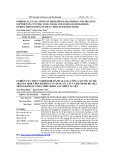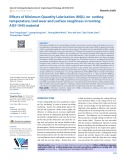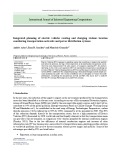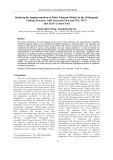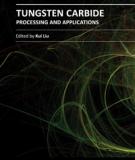
Cutting tool temperature
-
This study investigates the optimal ranges of high-speed machining and temperature that achieve a balance between cutting efficiency, cost reduction, improvement in surface quality, and extension of tool life.
 10p
10p  viironman
viironman
 02-06-2023
02-06-2023
 4
4
 1
1
 Download
Download
-
This research focus on to presents of the MQL parameters optimization approach in which the multi-response outputs based on Taguchi's L9 orthogonal array method is used. During the turning AISI-1045 steel, the cutting temperature, the maximum of tool wear, and the surface roughness were measured. The MQL parameters which are ratio of soluble lubricant and water, pressure of spray head, flow volume of emulsion was simultaneously optimized by taking the multi-response outputs using Taguchi based grey relational analysis (GRA) into consideration.
 11p
11p  trinhthamhodang9
trinhthamhodang9
 04-12-2020
04-12-2020
 19
19
 3
3
 Download
Download
-
Silicon carbide (SiC) particulate impregnated Al 7075 matrix composite was fabricated by stir casting method and then heat treated to T6 condition. It was then machined with multiple layer of TiN coated tungsten carbide (WC) inserts in dry environment and pollution free Spray Impingement Cooling (SIC) environment to compare the machining performance. SIC environment presented better machining performance with respect to cutting tool temperature (T), average roughness of the machined surface (Ra) and tool flank wear (VBc).
 16p
16p  toritori
toritori
 11-05-2020
11-05-2020
 8
8
 0
0
 Download
Download
-
The present study aimed to develop the predictive models of average tool-workpiece interface temperature in hard turning of AISI 1060 steels by coated carbide insert. The Response Surface Methodology (RSM) and Artificial Neural Network (ANN) were employed to predict the temperature in respect of cutting speed, feed rate and material hardness. The number and orientation of the experimental trials, conducted in both dry and high pressure coolant (HPC) nvironments, were planned using full factorial design. The temperature was measured by using the tool-work thermocouple.
 10p
10p  kequaidan1
kequaidan1
 16-11-2019
16-11-2019
 10
10
 0
0
 Download
Download
-
This paper presents the preliminary investigation on the implementation of two dimensional finite element modeling (FEM) with two approaches, Lagrangian mesh description and Arbitrary Eulerian-Lagrangian (ALE) mesh description, to simulate the stress and cutting temperature in the orthogonal cutting processes.
 8p
8p  visasuke2711
visasuke2711
 25-04-2019
25-04-2019
 24
24
 2
2
 Download
Download
-
Tungsten Carbide - Processing and Applications, provides fundamental and practical information of tungsten carbide from powder processing to machining technologies for industry to explore more potential applications. Tungsten carbide has attracted great interest to both engineers and academics for the sake of its excellent properties such as hard and wear-resistance, high melting point and chemically inert. It has been applied in numerous important industries including aerospace, oil and gas, automotive, semiconductor and marine as mining and cutting tools, mould and die, wear parts, etc.
 146p
146p  crius75
crius75
 02-01-2013
02-01-2013
 79
79
 6
6
 Download
Download
-
Metal cutting puts extreme demands on the tool and tool material through conditions of high forces, high contact pressures, high temperatures, and intense chemical attack by difficult to cut work materials. In addition, the tool geometry and cutting conditions in terms of sharp edges, cyclic engagement and presence of cutting fluid will add to the severity. Most often cutting tools are used close to their ultimate resistance against these loads, especially to the limiting thermal and mechanical stresses. ...
 14p
14p  cuunien
cuunien
 20-12-2010
20-12-2010
 113
113
 17
17
 Download
Download
-
6 Process Monitoring and Control of Machining Operations 6.1 6.2 6.3 Robert G. Landers University of Missouri at Rolla Introduction Force/Torque/Power Generation Cutting Force Models • Force/Torque/Power Monitoring • Force/Torque/Power Control Forced Vibrations and Regenerative Chatter Regenerative Chatter Detection • Regenerative Chatter Suppression 6.4 6.5 6.6 Tool Condition Monitoring and Control Tool Failure • Tool Wear A. Galip Ulsoy University of Michigan Other Process Phenomena Burr Formation • Chip Formation • Cutting Temperature Generation Richard J.
 19p
19p  medinova
medinova
 28-10-2010
28-10-2010
 92
92
 15
15
 Download
Download
-
Several developments made high-speed cutting (HSC) possible. HSC became an important trend in machining (Figure 5.2-1). The development of tool materials was a prerequisite to higher wear resistance under high temperatures. Up to the 1960s, the dualism of hardness and wear resistance on the one hand and toughness on the other were dominant limiting factors in tool materials. The functional separation of the ability to carry static and dynamic loads and of tribological functions was established by introducing coatings....
 4p
4p  vaseline
vaseline
 30-08-2010
30-08-2010
 99
99
 7
7
 Download
Download
-
This chapter presents basic knowledge on the special kind of the machining process in which a workpiece material hardened to 45–70 HRC hardness or more is machined with mixed ceramic or CBN tools. An extended comparison with finish grinding, as well with other abrasive finishing processes, is carried out. Specific cutting characteristics, including cutting forces, chip formation mechanisms and tool wear modes with relevant interface temperatures are discussed in terms of process conditions. Currently developing finite element (FE) and analytical modelling is overviewed.
 30p
30p  nguyen8
nguyen8
 30-11-2009
30-11-2009
 111
111
 12
12
 Download
Download







